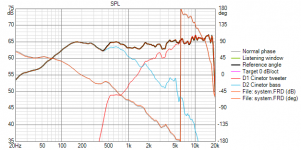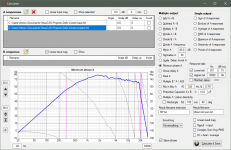zip all 4 files and send or attach please
Here are the files! Appreciate the help, thanks
Attachments
My answer was probably useless as too shady.
Few tips:
* Minimum phase extraction concept sucks so primary do not use it. It is needed if phase response is not included in frd/zma file, but better to just minimize excess phase or excess group delay by adjusting delay offset when phase response is included. No need to guess slope extensions manually or automatically when measured phase is used -> phase slopes do not corrupt due to bad subjective guess.
* Measure full audio band (5Hz-40kHz for VCAD) to avoid response extrapolation.
P.S. VituixCAD detects slopes within 1/3 octs at LF and 1 oct at HF. Detection stays stable and logical by using quite wide detection range. MP extraction is never accurate fact and very aggressive detection with narrow band does not necessarily help.
Few tips:
* Minimum phase extraction concept sucks so primary do not use it. It is needed if phase response is not included in frd/zma file, but better to just minimize excess phase or excess group delay by adjusting delay offset when phase response is included. No need to guess slope extensions manually or automatically when measured phase is used -> phase slopes do not corrupt due to bad subjective guess.
* Measure full audio band (5Hz-40kHz for VCAD) to avoid response extrapolation.
P.S. VituixCAD detects slopes within 1/3 octs at LF and 1 oct at HF. Detection stays stable and logical by using quite wide detection range. MP extraction is never accurate fact and very aggressive detection with narrow band does not necessarily help.
Equal result with equal slopes.
My answer was probably useless as too shady.
Few tips:
* Minimum phase extraction concept sucks so primary do not use it. It is needed if phase response is not included in frd/zma file, but better to just minimize excess phase or excess group delay by adjusting delay offset when phase response is included. No need to guess slope extensions manually or automatically when measured phase is used -> phase slopes do not corrupt due to bad subjective guess.
* Measure full audio band (5Hz-40kHz for VCAD) to avoid response extrapolation.
P.S. VituixCAD detects slopes within 1/3 octs at LF and 1 oct at HF. Detection stays stable and logical by using quite wide detection range. MP extraction is never accurate fact and very aggressive detection with narrow band does not necessarily help.
I get them to match if I have woofer delay set to zero in VCAD, while in XSim it's set to 1.4 inches. Really weird?

My simplistic but good enough for me measurement approach is:
- Gated measurements of tweeter and woofer at listening height
- Measuring both drivers wired in parallel
- Wire drivers in parallel in XSim, import parallel overlay and adjust woofer delay until the responses match up
I can't use measured phase since I'm using REW with a USB mic, so minimum phase it is.
Last edited:
I can't use measured phase since I'm using REW with a USB mic, so minimum phase it is.
Consider switching to Arta and an XLR mic with external sound card.
Best change I ever made for measuring speakers.
And I blame Kimmo/VituixCAD for dragging me kicking and screaming to this change...
Really weird?
As explained before, slope detection in VCAD uses 1 oct. band at HF. Result is about -9.5 dB/oct. with your tweeter and measurement range. I guess that you entered manually about -100 dB/oct to XSim. Difference is significant at XO range but one thing is sure: both are inaccurate because facts are not known.
good enough for me measurement approach is:
Why you ask anything if you really know what is good enough? Then you should be able to evaluate accuracy of different options.
I can't use measured phase since I'm using REW with a USB mic
Of course you can. USB mics are able to measure phase. Problem is that (usually) they are not able to measure timing differences between different drivers and off-axis angles without acoustical reference. Measurement programs adjust (=normalize) timing by shifting impulse peak to or close to 0 ms point with some logic.
Last edited:
kimmosto said:As explained before, slope detection in VCAD uses 1 oct. band at HF. Result is about -9.5 dB/oct. with your tweeter and measurement range. I guess that you entered manually about -100 dB/oct to XSim. Difference is significant at XO range but one thing is sure: both are inaccurate because facts are not known.
Why you ask anything if you really know what is good enough? Then you should be able to evaluate accuracy of different options.
MP function with manual slopes is also available in Calculator if automatic slope detection is not good enough or user wants to compare results.
But the issue here isn't slopes. I can play around with different slopes/tails, and it has minimal effect on the large 3-4 KHz dip.
VCAD and XSim matches up if Z=0 in VCAD and Z=1.4 inches in XSim. And that is what makes no sense to me.
kimmosto said:Of course you can. USB mics are able to measure phase. Problem is that (usually) they are not able to measure timing differences between different drivers and off-axis angles without acoustical reference. Measurement programs adjust (=normalize) timing by shifting impulse peak to or close to 0 ms point with some logic
So using an acoustical timing reference in REW I can actually trust the phase measurements? Thats good to know!
VCAD and XSim matches up if Z=0 in VCAD and Z=1.4 inches in XSim.
No. It's already visualized few messages earlier that programs give very close to equal result if you convert responses to minimum phase with the same tail settings. There's just tiny (~10 us) difference in group delay of tweeter causing ~1 dB difference in total SPL at 4-6 kHz.
Note that you have to use Calculator tool in order to imitate mp conversion of XSim.
Member
Joined 2003
Also CLIO (standard and pocket) looks externally a single channel system, but it's able to measure sound flying time. Key feature is capability to measure (externally or internally) timing difference between input and output streams which enables locking of timing to single point in 3D space (assuming that sound flying time stays constant).
Anyway, direct support for USB mics and owners doesn't look possible...best policy anymore. Requires much time and repeating without any hope for progress; transition from asynchronous/normalized timing to relative timing. Take this as motivation though it may look just punishment.
Anyway, direct support for USB mics and owners doesn't look possible...best policy anymore. Requires much time and repeating without any hope for progress; transition from asynchronous/normalized timing to relative timing. Take this as motivation though it may look just punishment.
I woke up this morning to a Vituix update and then saw a broken simulation. I had to delete and replace filter blocks and redo mirror equalizers but it still isn't right. Now its almost back to where it was provided I invert a response that didn't need inversion yesterday.
Before raising alarm, I decided to check another design and it is OK. I wonder where/how corruption set in. The program was closed over night. Any suggestions?
Before raising alarm, I decided to check another design and it is OK. I wonder where/how corruption set in. The program was closed over night. Any suggestions?
Member
Joined 2003
I understand your choice of path, but there will always be new users with a lack of understanding of phase interactions. It is simply easier to create bad data with single channel system IMO. Unfortunate, as I thought the time align tool in VituixCAD was of the best and easiest to understand tools for its purpose.
Some USB mic owners have been quite defensive and underestimated possible problems and restrictions, but needed basic support and explanations indicating that knowledge about phase normalization and minimum phase concept is not adequate for making well justified decisions.
Sometimes I've felt that it would be easiest and cheapest to buy all used Umik-1s and trash them than try to explain how to work with it and what my "utopia" is able provide.
At this point it's clear that VCAD supports methods compatible with measurement instructions, and does not try to please users who cannot cope with recommendation.
Sometimes I've felt that it would be easiest and cheapest to buy all used Umik-1s and trash them than try to explain how to work with it and what my "utopia" is able provide.
At this point it's clear that VCAD supports methods compatible with measurement instructions, and does not try to please users who cannot cope with recommendation.
Last edited:
Minimum phase checkbox removed from Drivers tab in the latest build. Preprocessing of response data will be the only choice.
I know that is you program, but is not good decision. Should be available, but maybe not on driver tab.
Sorry I use umik1 in car. Measurement for real phase in car is nor possible. I have semi dual equipment too.
Last edited:
Member
Joined 2003
Some USB mic owners have been quite defensive and underestimated possible problems and restrictions, but needed basic support and explanations indicating that knowledge about phase normalization and minimum phase concept is not adequate for making well justified decisions.
Sometimes I've felt that it would be easiest and cheapest to buy all used Umik-1s and trash them than try to explain how to work with it and what my "utopia" is able provide.
At this point it's clear that VCAD supports methods compatible with measurement instructions, and does not try to please users who cannot cope with recommendation.
I think there is some DIY mentality of wanting to do more with less, because that makes us appear to be clever. As well some pages back I mentioned that new users often look at USB mics as plug and play solutions without understanding the limitations. At some point people just have to bite the bullet and see what they're missing. I moved over to 2 channel methods some years back with SoundEasy, and recently moved over to VituixCAD and ARTA, never looked back at USB mic for design purpose, there is no reason. I still keep the USB mic of course, it has it's uses for things like room EQ as plug and play solution.
- Home
- Design & Build
- Software Tools
- VituixCAD

